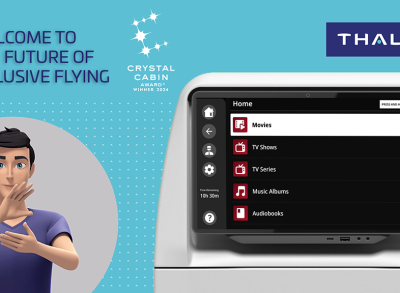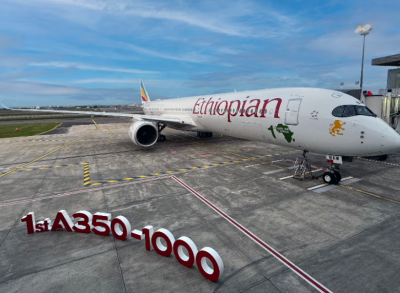Farnborough 2016: The connected airline is the future of the market
OnBoard spoke with Gil Michielin, VP of Avionics activities on the biggest themes for Thales at this year's Farnborough air show. The overall message is that the connected airline is the future of the market.

At the recent IATA conference, cybersecurity and a cut in emissions were identified as industry driving forces. The solutions we are showcasing at Farnborough also address these drivers while encompassing the issue of maintaining airlines’ operational performance and profitability.
Thales is the only player on the market that enjoys a true leadership position across aircraft segments, from ATM where we are world leaders, to IFEC where we are the world’s number two, through cockpit systems, avionics and services. By combining this with our world-class cybersecurity activities, Thales boasts a technology base and know-how which is unparalleled across the aerospace sector.
On the connected aircraft front, what are the breaking points?
We’ll be demonstrating how all the segments of the aircraft can be connected and what impact this has on operations and an airline’s bottom line.
Before the pilot is even on board and throughout their mission in the air, they are given tools to execute the mission more efficiently. On the ground the aircraft can be immersed as part of a network of all other aircraft, all connected to the Tower which can plan all airside operations to minimise downtime. In the cabin the crew can inform the airline operations centre of any maintenance issues and stock taking issues before the airplane touches down, ensuring everything required for fast turnaround is waiting for the aircraft.
How is this achieved?
Our connected electronic flight bags enable the pilot to share massive amounts of data with the airline operations centre when planning the mission. This can even be from the comfort of a hotel room where they are being provided with the most up-to-date weather and traffic information.
On the ground, airport maps can provide real-time position and tower directions, and soon the positions of other connected aircraft. This means everyone shares information to ensure a speedy taxi process. This is important as a typical widebody aircraft consumes up to 8kgs of fuel per minute when stationary. So every second counts! In the air an aircraft, connected to ATC centres, which in turn are connected to all other ATC centres along the route, can plan the best flight path, enabling unparalleled situational awareness to ensure as few costly detours as possible. When you consider that a routine 40-kilometre detour on a transcontinental route, due to congestion or weather, translates into 200kgs of fuel for a widebody aircraft, anything we do to prevent that is a step in the right direction both for emissions and the airline’s bottom line.
Then there’s the cabin. Connectivity has slowly but surely been making its way into cabins through IFE systems and through connection that enables passengers to use their portable devices. We are at the point now where we can present, here at Farnborough, all the revolutionary technology that will enable airlines to create a truly customised, connected passenger experience.
How does this help an airline to turn the IFE into a revenue generation centre?
Thales estimates that 70% of the global fleet will be connected by 2024 and the result of high-speed connectivity is more robust data exchange between the passenger and the airline.
As with online engagement on the ground, passengers will become more actively engaged and will no longer be just passive absorbers of content: they will tweet about flights services and interact on social media networks actively impacting the airline’s brand; they will browse the internet and shop; they will provide the airline with big data information on behaviour and trends.
An example of this is the steady increase in ancillary revenue generation potential. In 2015, total ancillary revenues for global airlines were estimated at US$ 60B (e.g. baggage fees, frequent flyer miles, seat upgrades, in-cabin) and Thales estimates it will grow at 8% annually over the next 10 years. The in-cabin share of revenues currently represents about 10% of the total, and is expected to grow at 13% annually during the same period. As IFE becomes more connected and payment methods more secure, airlines will be able to increase the type and variety of goods and services on offer.
This can only be achieved if IFEC can offer secure payment methods. Most payments are currently made offline, meaning that the airline cannot confirm if the credit card is accepted until the aircraft reaches its destination. We are leveraging our position in financial transaction security to achieve the highest PCI compliance of any IFE provider. This means that more retailers and services feel secure in offering their products/services on board, increasing the amount of goods and services on offer.
In addition, by utilising big data, a connected IFEC system will be able to offer a personalised experience tailored to each passenger, which can begin well before flight and carry on afterwards. By knowing web surfing patterns, the airline will be able to tailor offers and push monetisation opportunities. At the same time big data will drive more efficient branding and customer retention efforts by keeping them interested in their offers. Passengers are already given the opportunity to scroll thought IFE content on their smartphone as they do their online check-in, choosing their entertainment, meal and even doing some shopping.
What are you expecting from Farnborough 2016?
A good show and as usual a great opportunity to meet up with our customers, partners and suppliers!
Stay connected with us...
Find us on Twitter @thales_avionics, on our official Youtube channel and on LinkedIn Thales Aerospace.




